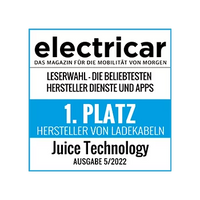Charging made easy
With our JUICE BOOSTER 2 you are well prepared for your next trip. Let's assume...
... You stop at a motorway service station with an electric charging station. You simply pull out your JUICE BOOSTER 2 with the Type 2 adapter and charge your Model S at 32A at around 100 km per hour. If there is no Mennekes (Type 2) plug, then your CEE32 will definitely fit, otherwise at least your CEE16 will.
... you're driving into the mountains or the countryside. Stop at a really nice restaurant and say: "I'll order a nice big steak from you, if I can plug in 400V 16A in your tumble dryer or in your kitchen in the meantime, please." Make a big eyed noise. Then casually unpack the CEE16 (or T15 in Switzerland) adapter and fit an extension if necessary.
... you're stuck in electrical no man's land. Then a small selection of adapters (covers every European country) and the JUICE CONNECTOR extension cable will help. This way you can charge safely at 13A (and not just at 10A, which is what normal adapter fuses force you down to). In this case, the E-TRAVELLER 2 bag still has a small space for your pajamas and a toothbrush (not included).
... You get lost on a campsite. There you find the blue 16A single-phase plug. You are even prepared for this - a good feeling, isn't it?
Is the width sufficient?
As an e-driver, you save a lot of money. Mainly because you never have to pay for admission to the cabaret again. Because you have that every day in contact with people who refuse to accept progress:
"You have a great car, but what's the range?" people on the street ask you. It doesn't matter what you say, whether it's "150 km" or "400 km", they turn up their noses on principle and say things like "yes, that's a problem". Because they usually drive around 50 km a day - and calculating has always been difficult.
You can find more information about electric vehicle models in our directory: Vehicles

In a way, it's a bit like with mobile phones. When the first smartphones came out, people said clever things like "how long does your smartphone last? I only have to charge my old phone every 14 days." As if it was an advantage to wait two weeks instead of just plugging it in every evening. With the telephone, it took almost three years for the smartphone to become commonplace in every grandpa's home. With cars, let's add another three years, so by 2020 most people will have realized that range is not a problem.
How is reach defined?

Range means the autonomy, how far a car can travel without an external energy supply. And that brings us to the crux of the matter: when and where do I supply external energy?
Back to the mobile phone: Nobody thinks about when and where to charge a mobile phone anymore. You just plug it in. At home overnight of course, and also when you run out of power during the day. There are even portable batteries for phones, such as the e-Juice Bar, so you can charge them at any time. Now explain to me why you shouldn't do the same with a car. Every morning you have a full tank of fuel. On the 10% of days a year when you drive further than your range allows, you simply recharge on the way, wherever you stop. It's that simple.
charging infrastructure
charging on the go
Where can you charge on the go? Well, wherever you are. Most people have trouble breaking away from the familiar. That's why there's always talk of e-charging stations. Even visionary traffic planners then design large covered halls or container ghettos because they assume that people have to make a pilgrimage to gas stations, like a thirsty ox to a watering hole. Of course, you can make good use of such gas stations, especially if they are on the way. And they are now doing that quite often, as you can easily see in the picture below. But you can just as easily take your own mobile charging station with you and charge your vehicle at any socket. It couldn't be easier.
The future, however, will be one where you can charge your car wherever you are. Just like with your mobile phone. Any power outlet is de facto a gas station.
Due to the natural decentralization, this also solves the problem of having to supply large amounts of electricity to gas stations. For once, the simplest solution is also the best!

This map shows all public charging stations for electric vehicles registered on www.chargemap.com .
mobile charging station
Much easier than planning and much more convenient: Pack our Juice Booster in the trunk, for example. Drive off and when your juice runs out, stop wherever you like. Electricity is available everywhere and you will make contacts and experiences that ultimately make the journey charming and the joy of life. And when we listen to the readers of this platform, most of them say that they combine these two tips. It slows things down without wasting time. And it makes life richer, because as we said: the journey becomes the destination again. Confucius would enjoy an electric car.

The most common installations at home
Before you plan a charging installation, you should clarify the technical possibilities at your location. This is best done by a qualified electrician, for example someone from our installation service. Below you will find three examples of what an installation could look like in different situations.
underground car park
There are three electric cars in an underground car park. Since the underground car park is in a residential area, charging overnight is a good idea, so one AC charging station is sufficient. We recommend installing three wall charging boxes equipped with smartJUICE.
outdoor parking space
A resident has rented an outdoor parking space for his electric car. It is right next to the neighbor's house, so a power line can be laid from the neighbor's basement to the parking space - with their consent, of course. Since it is visible to everyone from outside, a charging station with an attractive design is recommended - for example a charging box like the Juice Charger 2 or a charging column like the Juice Tower.
private garage
In the house next door, an electric car has also been purchased. However, since the house is only used as a holiday home, a permanent installation is not recommended. The best option is to install a wall bracket to which a mobile charger (recommended: Juice Booster 2) can be attached, so that it can be used in exactly the same way as a fixed charging station.













